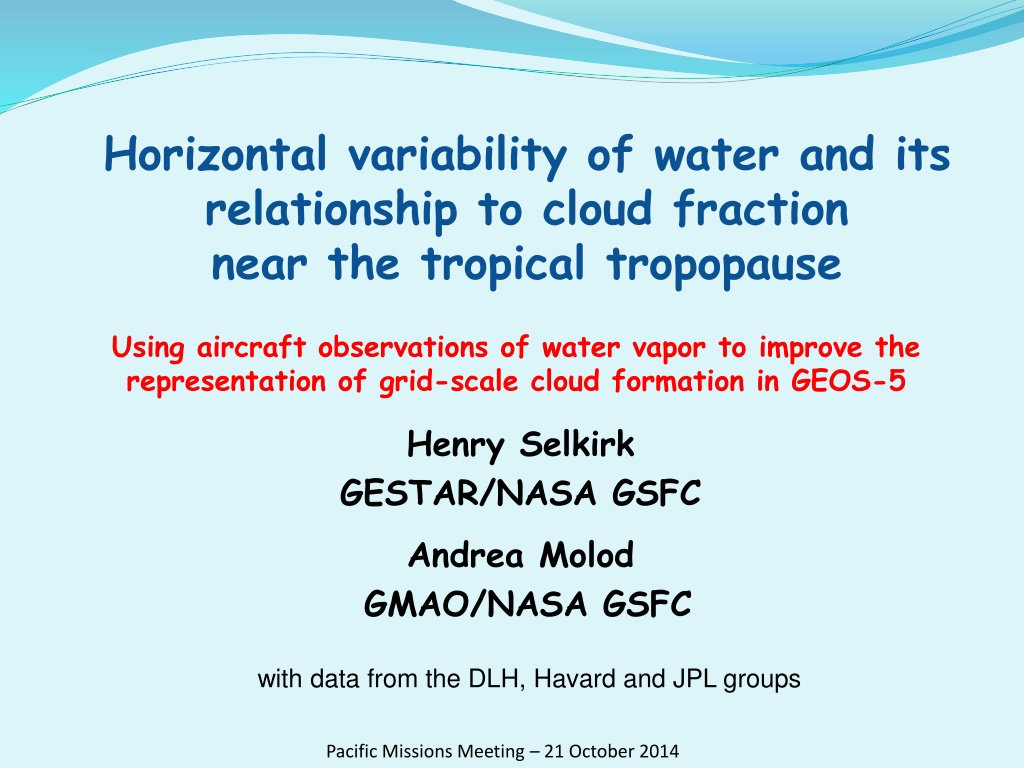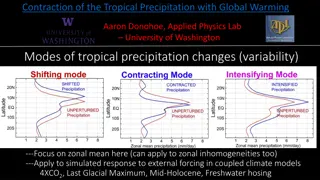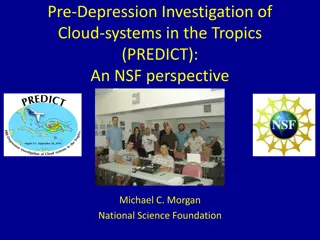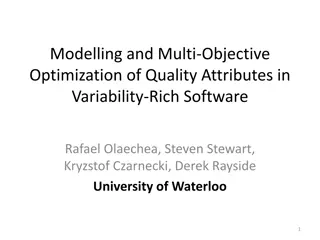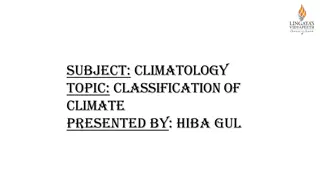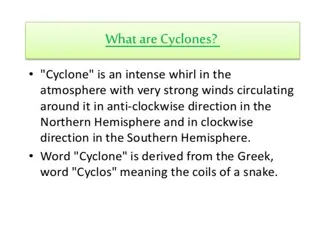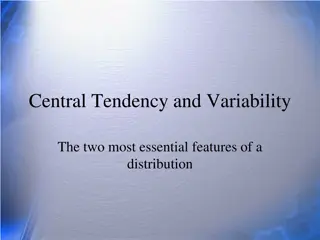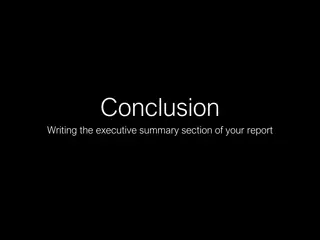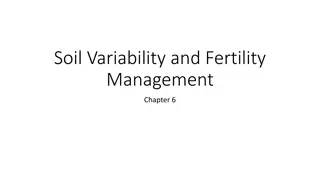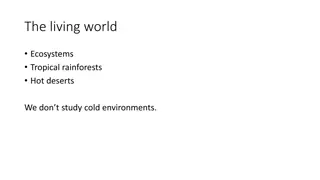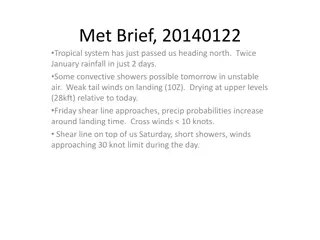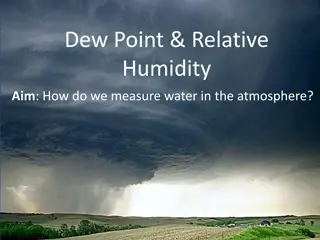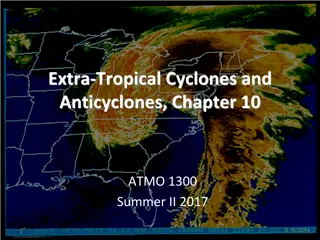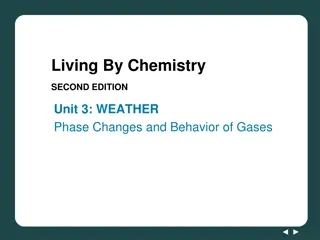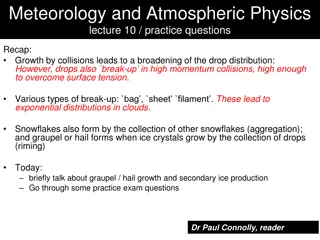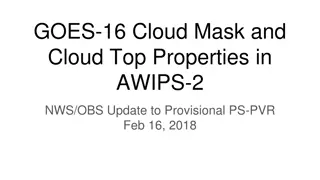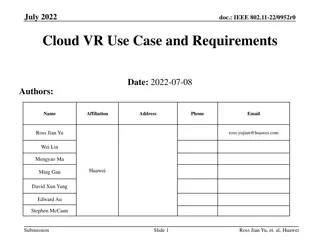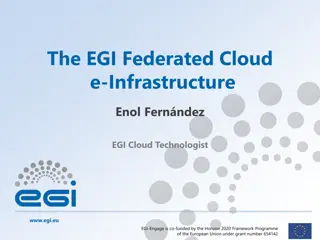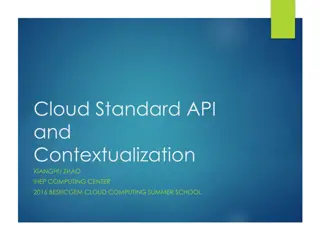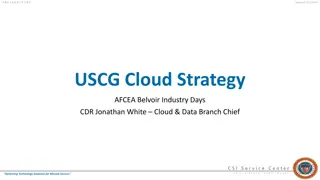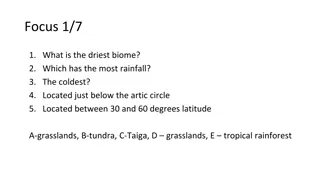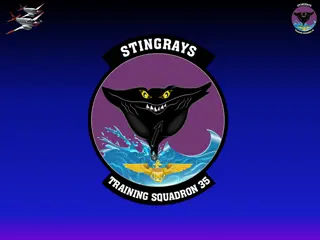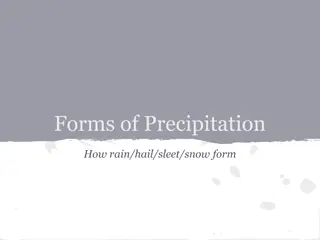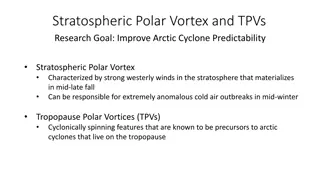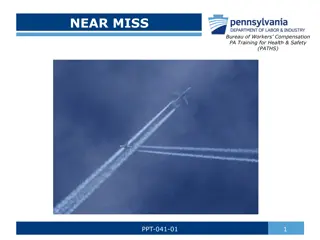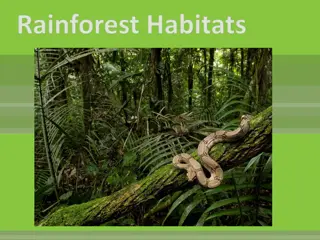Understanding Water Variability and Cloud Formation near Tropical Tropopause
Exploring the horizontal variability of water and its relation to cloud fraction using aircraft observations to enhance grid-scale cloud formation representation in GEOS-5. Addressing the chronic water vapor issue in GEOS-5, potential causes, motivating science questions, and methodologies to improve data accuracy and achieve long-term goals. Discussions on the water budget in the upper troposphere, cloud formation processes, and implications of a warming atmosphere.
Download Presentation

Please find below an Image/Link to download the presentation.
The content on the website is provided AS IS for your information and personal use only. It may not be sold, licensed, or shared on other websites without obtaining consent from the author. Download presentation by click this link. If you encounter any issues during the download, it is possible that the publisher has removed the file from their server.
E N D
Presentation Transcript
Horizontal variability of water and its relationship to cloud fraction near the tropical tropopause Using aircraft observations of water vapor to improve the representation of grid-scale cloud formation in GEOS-5 Henry Selkirk GESTAR/NASA GSFC Andrea Molod GMAO/NASA GSFC with data from the DLH, Havard and JPL groups Pacific Missions Meeting 21 October 2014
Talk topics The chronic water vapor problem in the GEOS-5 Two possible source and a potential remedy for one Motivating science questions Overview of cloud processes in GEOS-5 Methodology: estimating RHcrit from aircraft data Initial results from TC4: DC-8 and WB-57 Summary, long-term goals and future work Pacific Missions Meeting 21 October 2014
The chronic water vapor problem in the GEOS-5 GEOS-5 GEOS-5 ERA-Interim ERA-Interim 300 hPa 100 hPa Difference Difference GEOS-5 tropics are too wet at 300 hPa but too dry at 100 hpa Pacific Missions Meeting 21 October 2014
GEOS-5 vs. MLS GEOS-5 Pacific Missions Meeting 21 October 2014
Two possible causes of the problem: Convective scheme not lofting condensate high enough Evidence from ice water Evidence from CO Suggestions from TOA radiative balance (OLR, SW) At high-res (7 km) with RAS turned way down, problem goes away! Vertical distribution of condensation processes not properly captured Currently extrapolating AIRS results into UT where AIRS provides little information Need more observations in upper troposphere Pacific Missions Meeting 21 October 2014
Motivating Science Questions What physical processes control the water budget in the upper troposphere and lower stratosphere? What is the relationship between thin, cold clouds and supersaturation? Given depletion of vapor by numerous small ice particles, are there really extended regions of supersaturation? What are the causes of the fine structure of water vapor and what are the implications for cloud formation? How will each of these respond to a warming atmosphere? Pacific Missions Meeting 21 October 2014
Large-scale cloud processes and sub-grid scales in GEOS-5 Like many AGCMs, in GEOS-5 a simple, two-parameter Top-hat PDF distribution relates grid-scale q and cloud fraction to subgrid-scale variations of q Vertical variation of top hat PDF width obtained with information from AIRS But AIRS provides no real information above 300 hPa, so current PDF falls back to a simple extrapolation Pacific Missions Meeting 21 October 2014
The PDF formalism qT - total specific humidity P(qT) the distribution of qT within the grid box Cloud fraction (Cf) the portion of a model grid box where qT > q*(T) formally expressed as integral of P(q) from q* to infinity PDFs such as the Top Hat are simplification of P(qT) Width of PDF is standard deviation of qT or sigmaT Define RHcrit = 1-sigmaT/ q*(T) => RHcrit is the threshold for condensation in a grid box expressed in terms of the grid-scale quantities, i.e. condensation if RH > RHcrit q*(T) - grid-box mean saturation specific humidity Pacific Missions Meeting 21 October 2014
Top-hat PDF parameterization Narrowest distribution: no condensate unless grid box mean q > q* Narrower distribution: no Wider distribution: Fraction under curve beyond q* is the condensate condensate (can generate condensate if grid box mean q < q*) PDF of Grid Box Total Water RHcrit= 1-sigmaT / q*(T) Triangular need 3 parameters (assymetry) Beta need 4 parameters Other distributions in the literature, but derived parameters from CRM: Pacific Missions Meeting 21 October 2014
Estimating RHcrit with aircraft observations 1. Break aircraft flights into level-leg segments equal to model resolution (e.g. 100 km for 1 2. Estimate sub-grid scale variability in segment with sigma, the standard deviation of specific humidity q 3. Estimate large-scale saturation specific humidity q* in segment 4. Derive RHcrit = 1- sigma/q* x 1 ) Pacific Missions Meeting 21 October 2014
Example of DC-8 transit, Dryden to Costa Rica L E G E N D D L H W W V s t d e v P r e s s u r e V Z o n a l w i n d T s t d e v 1 2 0 0 0 . 6 1 2 0 1 0 0 0 2 0 0 . 5 1 0 0 a t e r v a p o r m i x i n g r a t i o ( p p m v ) S t D e v W a t e r V a p o r ( p p m v ) S t D e v T e m p e r a t u r e ( K ) - 1] P r e s s u r e ( h P a ) Z o n a l w i n d [ m s 8 0 0 1 0 0 . 4 8 0 6 0 0 0 0 . 3 6 0 W 4 0 0 - 1 0 0 . 2 4 0 2 0 0 - 2 0 0 . 1 2 0 0 0 . 0 0 4 5 4 0 3 5 3 0 2 5 L a t i t u d e [ N ] 2 0 1 5 1 0 5 DLH WV mixing ratio and standard deviation (ST DEV) of water vapor and temperature for 200-km on the DC-8 transit, NASA Dryden to Costa Rica, 13 July, 2007. Also plotted are flight-leg pressure and the zonal wind. Pacific Missions Meeting 21 October 2014
TC4 Specific Humidity Top-hat PDF parameterization 100 DLH (DC-8) DLH HU Harvard (WB-57) q*(T) q* (T) 200 Pressure [hPa] 300 Mean TC4 Specific Humidity and q* 400 12 DC-8 flights and 6 WB-57 flights 500 0.01 0.10 1.00 10.00 Triangular need 3 parameters (assymetry) Beta need 4 parameters q [g/kg] Other distributions in the literature, but derived parameters from CRM: Pacific Missions Meeting 21 October 2014 Pacific Missions Meeting 21 October 2014
Top-hat PDF parameterization DLH (DC-8) Harvard (WB-57) TC4 sub-grid scale variability of q 12 DC-8 flights and 6 WB-57 flights Triangular need 3 parameters (assymetry) Beta need 4 parameters Other distributions in the literature, but derived parameters from CRM: Pacific Missions Meeting 21 October 2014 Pacific Missions Meeting 21 October 2014
RHcrit estimates from TC4 TC4 RHcrit Top-hat PDF parameterization Spread ofRHcrit at lower levels may suggest dependence on other factors, e.g. temperature 100 270 260 250 200 Higher RHcrit near tropopause from aircraft data would inhibit formation of condensate and thus lead to moistening Pressure [hPa] Temperature [K] 240 230 300 220 210 DLH (DC-8) 200 400 MODEL RHcrit Harvard (WB-57) 190 500 60 80 100 120 140 160 Triangular need 3 parameters (assymetry) Beta need 4 parameters RH [%] Other distributions in the literature, but derived parameters from CRM: Pacific Missions Meeting 21 October 2014 Pacific Missions Meeting 21 October 2014
Summary GEOS-5 has a chronic problem of excess moisture at 300 hPa and above in tropics but too little at trop Improvement may come by informing PDF parameterization of condensation through estimates of RHcrit profile with aircraft water vapor measurements Have done this for a single tropical airborne mission (TC4) Encouraging results: Higher RHcrit than AIRS-based estimate near the tropopause (above 200 hPa) should lead to moistening Below 200 hPa seeing spread of estimates, suggesting different large-scale condensation regimes Pacific Missions Meeting 21 October 2014
Long-term goals Reduction of tropical UT wet bias of GEOS-5 Improved TOA radiative balance Improve moisture at tropical tropopause With new microphysical scheme, achieve better understanding of water vapor budget & microphysical processes in tropical UT/LS Improved model fields for better interpretation of airborne measurements Pacific Missions Meeting 21 October 2014
Carrying on ATTREX/CONTRAST/CAST provide an extraordinarily rich database of water vapor measurements, particularly in the gap between the DC-8 and high-altitude platforms Other missions, other environments & seasons: CR-AVE, MACPEX, SEAC4RS, HIPPO Model runs and validation with observational data Analysis of remote sensing data for sub-grid variability CPL data CALIPSO overpasses of opportunity Develop state-dependent PDF parameterization for large-scale models (probably not a simple top-hat) Pacific Missions Meeting 21 October 2014
